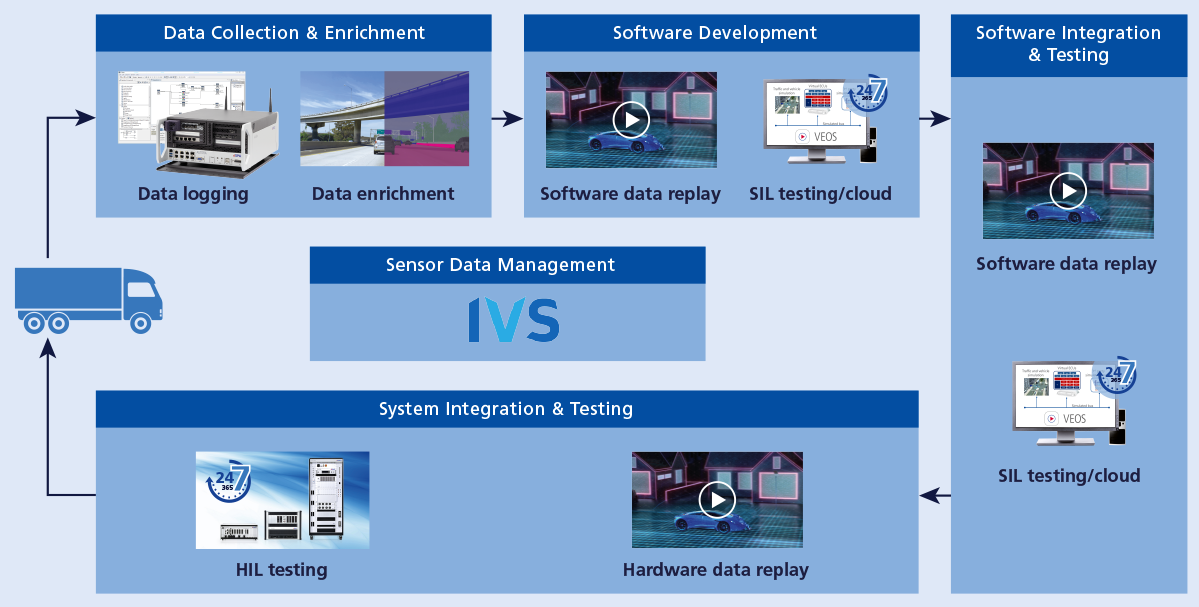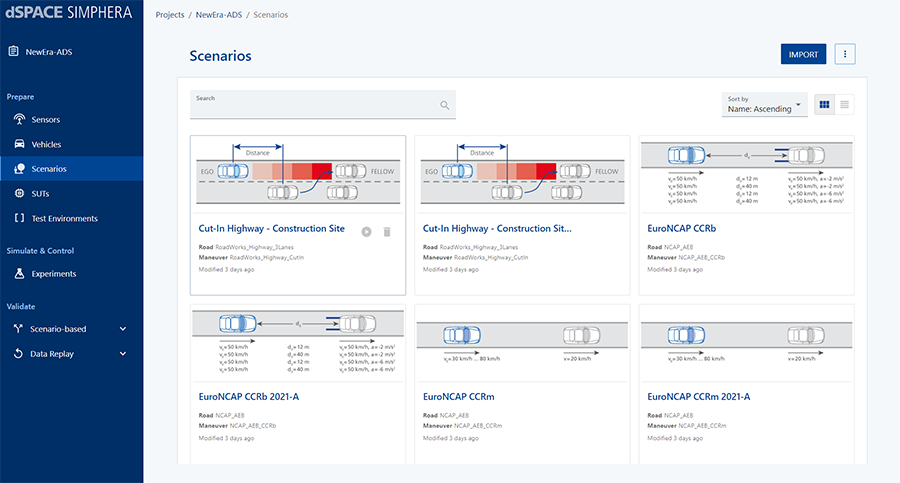Barely any innovation concerns the transportation industry more than autonomous driving. With dedicated feasibility studies and a data-based as well as cloud-based approach to development and virtual validation, MAN is demonstrating how autonomous driving can be made suitable for everyday use.
The digital transformation already offers freight transport a wide range of opportunities to increase efficiency and reduce costs through networking, GPS logistics, assistance systems, etc. Autonomous driving promises particular potential. Transporters that drive autonomously enable a continuous flow of goods between producers, production sites, warehouses, ports, transshipment points, and customers. This scenario is almost perfect for the transportation and logistics industry. For important sections – especially confined areas – the feasibility has already been proven by studies.
Autonomy for Efficiency
“At the port of Hamburg, for example, an autonomously driving truck heads for the container terminal and independently and precisely finds its way to the transshipment point,” explains Dr. Eva Karrer-Müller, Senior Manager, Electric/Electronic Validation ADAS & Automation, MAN Truck & Bus SE. A safety driver monitors the journey as well as the automatic loading and unloading. The Hamburger Hafen und Logistik AG achieved this success together with MAN in the joint Hamburg TruckPilot project. Further pilot projects show valuable potentials for efficiency and prove the feasibility and practical suitability of autonomous systems:
- EDDI: Truck platoons (convoy journeys) in real logistics operations with the project partner DB Schenker
- aFAS: An unmanned safety vehicle follows fully automated mobile roadworks.
- ANITA: The ‘Autonomous Innovation in Terminal Operations’ makes it possible to use vehicles more flexibly by controlling the container handling process more efficiently and decoupling it from truck drivers' driving and rest times.
Key findings from the projects include lower fuel consumption through predictive automated driving, increased safety, and reduced manpower requirements in times of increasing staff shortages. Claus Hellberg, Vice President, Head of Electric/Electronic Verification & Validation, MAN Truck & Bus SE, emphasizes: “Autonomous driving has the potential to fundamentally change transportation.”
Developing Autonomous Drivers Instead of Functions
What is particularly appealing to customers and users from the transportation industry, however, presents developers with exciting challenges. Level 4 automation causes immense, additional complexity for the development and validation of driving control. It not only involves the development and testing of technical functions but the replacement of the human driver as best as possible. Lorenz Bernwieser, Team Lead, Electric/Electronic Validation ADAS & Automation, MAN Truck & Bus SE, summarizes the challenges, “To build trust in the artificial autonomous driver, it needs to prove itself by driving accident-free in relevant test scenarios.”
Advantages of Autonomous Freight Transport
- More safety on the roads and smoother traffic flow
- High reliability and availability
- High availability boosts the customer’s business
- Potential for new services
- Lower overall operating costs
- Compensation of driver shortages

How will autonomous driving become economically successful?
The challenge facing an original equipment manufacturer (OEM) is to efficiently implement and execute a new procedure with new methods and components alongside the traditional development methods. This includes the recording of sensor data, machine learning, data-driven development and validation. “For this purpose, know-how has to be built up and new processes and tool chains have to be developed and implemented, under high time and cost pressures,” reports Claus Hellberg.
Achieve Success Efficiently
MAN evaluated various providers of process consulting and of development tools for the introduction of an efficient, sustainable approach. It quickly became clear that for the best possible success, a comprehensive solution from a single source was desirable. Specifically, MAN was looking for solution expertise from data recording campaigns to homologation. The solution components already available or under development at dSPACE, supported by consultancy and engineering services as well as a partner network, were convincing and led to a cooperative partnership which is planned to last several years. Reasons to choose dSPACE:
- Extensive process knowledge for the validation of advanced driver assistance systems (ADAS) and systems for autonomous driving (AD)
- Established solutions for the virtualization of electronic control unit (ECU) functionality (V-ECU).
- End-to-end portfolio for data-driven development from data acquisition to annotation and subsequent data management.
- Proven competence and experience in simulation and validation in the fields of hardware-in-the-loop (HIL) and software-in-the-loop (SIL).
- SIMPHERA, the cloud and on-site solution for highly scalable simulation of countless driving kilometers with relevant driving scenarios
- Partner network for additional subjects
Due to many years of cooperation in previous development projects with conventional, model-based development and validation based on hardware-in-the-loop (HIL) simulation, MAN had a high level of confidence in dSPACE's reliability.
Partnership-Based Process Development Leads to the Goal
“Together with dSPACE and further partners, the multistage test strategy for the validation of an emergency brake assistant (EBA) was developed. This serves the preparation of further validation steps for future L3/L4 functions,” explains Dr. Eva Karrer-Müller. The designed process introduces the paradigm shift of data-driven development and is created for the highest possible consistency. Software development and validation proceeds in the following steps:
- Targeted data recording during test drives
- Data ingest and data enrichment (annotation, tagging, selection)
- Data replay for development and testing, primarily in SIL but also using the HIL simulator.
- Iterative simulation and validation throughout the development
- Derivation of homologation arguments
A Solution Tool Chain That Delivers
Suitable, powerful tools and competencies are required to successfully address the diverse issues associated with autonomous driving. Together with dSPACE, an integrated tool chain, with which developers can meet the many challenges, was designed, iteratively developed, and put into operation:
- MAN relies on the AUTERA AutoBox in-vehicle data logger to record all data (raw sensor data, camera videos, bus data, XCP data).
- With the help of the AUTERA Upload Station, the recorded data is imported into the storage systems and thus made available to the developers.
- The data is structured and organized using IVS, the sensor data management platform. The developers can access the data from all processing steps at any time and the management of the huge amounts of data is simplified.
- Virtual ECUs are created as test objects based on the production code and produced in the context of a continuous integration (CI) build pipeline.
- Using SIMPHERA, the ISO26262-certified, central, web-based simulation and test platform, open- and closed-loop test executions are configured and scaled test execution in the cloud is orchestrated.

These tool chains and methods support the end-to-end process and have proven to be effective in developing and validating the AD stack. The IVS sensor data management platform ensures maximum consistency.

Insight into a Development and Validation Step
A practical example shows how this works in the everyday development environment of an electronic control unit (ECU). The ECU is initially created as a virtual control unit (V-ECU). MAN has to integrate their own code and components from suppliers in such a way that they remain performant, function correctly, and meet special V-ECU requirements. The following process is used for validation:
- Inclusion of integrations and of the build of the V-ECUs in the MAN continuous integration (CI) pipeline
- Validation of requirements in the area of real data via highly scaled data replay testing in SIMPHERA
- Validation of complex, safety-critical scenarios by means of scenario-based testing with highly scaled simulations in SIMPHERA
This process is carried out iteratively until the software meets the defined requirements. The software is integrated in parallel on the real ECU, and further tests are performed on the hardware-in-the-loop (HIL) simulator for selected operating points (corner cases). With SIMPHERA as a central platform, test scenarios and artifacts from SIL simulation can be used further in HIL testing. This also applies to the simulation models including their parameterizations. The scenarios used in the SIL tests are already available for selection in SIMPHERA or were created additionally for special application situations. The test parameters of the individual scenarios, such as speed, distances, etc., can be conveniently varied automatically in SIMPHERA to achieve high test coverage.

Why do we need scalable simulations?
Autonomous drive controls must meet the highest safety requirements. Every new software version of a drive control system must prove its safety in extensive tests: It must successfully manage many millions of miles of travel without catastrophic accidents. It would take decades to verify this with real-time testing. To shorten the test times, relevant safety-critical test scenarios are carried out in parallel. This is where the SIMPHERA simulation solution comes into play because it not only enables parallel simulations in the cloud, but also masters the entire spectrum of validation methods.

Evaluation of the Procedure
An emergency brake assistant that complies with the latest regulations is developed in the described validation process and procedure. Real test drives validate the degree of software maturity as an accompanying measure. In everyday development, the commonly designed process and tool chain prove their high suitability for the further demanding project on a daily basis: They will be successively rolled out to other Level 3 and Level 4 driving functions and make an essential contribution to overall validation. “As a leading customer, MAN is closely involved in the SIMPHERA development process, and there is regular mutual adjustment. The targeted, rapid approach succeeded in particular due to agile collaboration, which enables flexible responses to new requirements,” reports Lorenz Bernwieser. In a partnership approach, the solution expertise of dSPACE and MAN was combined efficiently.

Methods and test environments for validation: A mixture of data replay (DR) of real sensor data and synthetically generated scenario-based testing (SCBT) on SIL and HIL platforms.
Autonomous Driving Will be a Gamechanger in Transportation
“The partnership project lays an important technical foundation for autonomous driving in freight transport,” summarizes Claus Hellberg. Autonomous trucks are already driving in the virtual world and learning from the experience gained there. The replay of real sensor data combined with synthetically created scenarios forms a successful test mixture for the maturity of the algorithms. An important future topic arises with the homologation of the autonomous vehicle. The range of solutions provided by dSPACE is supplemented for this purpose by tools and services from dSPACE partners. The findings from studies and technical innovation show: AD is a game changer for the transportation industry.
With kind permission of MAN Truck & Bus SE
dSPACE MAGAZINE, PUBLISHED APRIL 2023
Consulting and Engineering Services
The development of complex E/E systems and software with more and more safety-critical functions, especially in the field of autonomous systems, raises the question of how to ensure functional safety. At the same time, ways for new efficient development need to be found. In the areas of functional safety, test strategy development, and verification and validation, MAN relies on dSPACE expertise and consulting to ensure a competent and efficient approach. dSPACE Consulting Services take on important conceptual tasks and ensure their efficient and successful implementation in the MAN project.











